Monkey Grass (Liriope): Plant Care and Growing Guide

Monkey grass is a low-growing, easy-care evergreen grass-like plant that is ideal for ground cover or turfgrass replacement. Also called lilyturf, monkey grass is easy to plant, survives drought, and is useful to decorate garden landscapes. You can plant monkey grass as edging plants, perennial flowering border grass, lawn substitute, shade-loving plant for under shrubs, or prevent soil erosion.
There are two main types of monkey grass plants common in residential gardens: clumping monkey grass plants and creeping plants. One reason monkey grass is so popular is that it’s very adaptable. Monkey grass grows in full sun to complete shade, grows in various soil types, and requires little maintenance.
This article is a complete guide to planting and growing monkey grass in your garden. You will also find out the best way to plant this grassy plant to enhance aesthetics in your front or backyard.
What is Monkey Grass
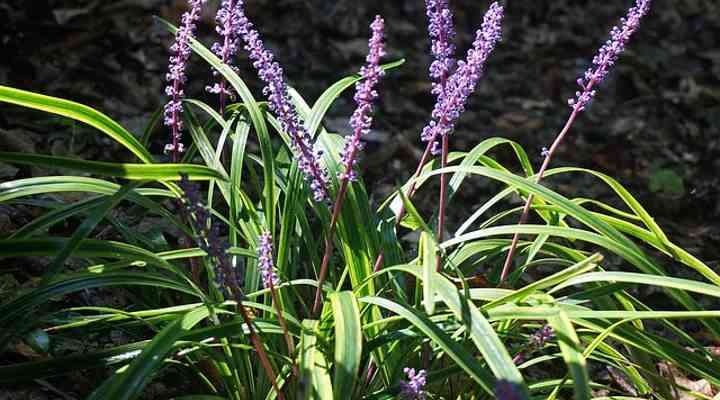
Monkey grass (lilyturf) is a low maintenance and easy to care for flowering grass-like plant that can enhance any garden’s landscape
Monkey grass is a group of grass-like flowering plants in the genus Liriope and family Asparagaceae. This low, grass-like plant grows in clumps or as a creeping plant. Monkey grass has long, slender, pointed green leaves and purple or white flowers. This spreading, clumping plant also produces purple or black berry-like fruits.
Like many ground-cover plants, monkey grass has rhizomes that spread underground. Due to its fast growth, some species of monkey grass spread quickly in gardens.
The common names for species of Liriope—monkey grass and lilyturf—can be misleading. Monkey grass isn’t a true type of turfgrass as it’s not in the lawn grass family Poaceae. Additionally, monkey grass isn’t related to lily plants (Lilium). Because of its resemblance to spider plants (Chlorophytum comosum), the grass-like clumps are also called spider grass.
When deciding on the ideal type of monkey grass for your garden, it’s vital to choose the right variety. Liriope spicata is the creeping variety of monkey grass. This plant spreads rapidly and is ideal for ground cover—however, it can become invasive. Liriope muscari is the non-spreading monkey grass plant variety that grows in bushy clumps.
Monkey grass is also a flowering plant species. The ornamental grass-like plant blooms into life in late summer with spikes of small bluish-violet flower spikes. These purple flowers contrast nicely with the green ribbon-like leafy foliage.
Monkey Grass Vs. Mondo Grass
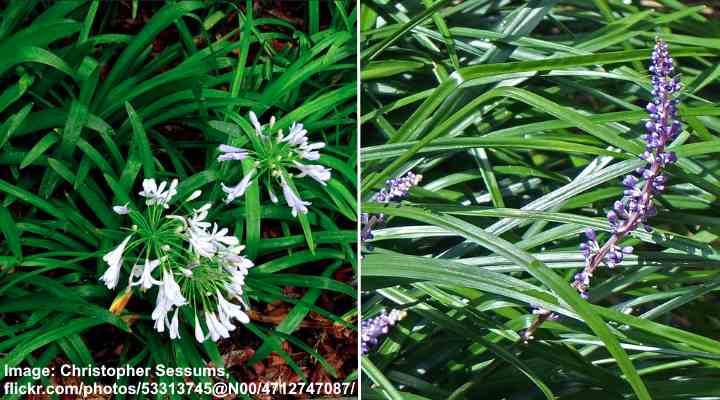
Mondo grass vs. Monkey Grass – in the left picture: Mondo grass (Ophiopogon japonicus). Right picture: Monkey grass (Liriope) which is also referred to as lilyturf
Monkey grass sometimes gets mistaken for mondo grass. Although both species of plants look similar, there are some differences. For example, only plant species in the genus Liriope are types of monkey grass. Mondo grass is an ornamental plant in the genus Ophiopogon. However, both plants are members of the asparagus family Asparagaceae.
To tell the difference between monkey grass and mondo grass, examine the leaves. Monkey grass (Liriope) has wider blades and is thicker than mondo grass (Ophiopogon). Comparing the two species, you’ll notice that monkey grass is more clump-forming and taller than types of mondo grasses.
Monkey grass grows between 10” and 15” (25 – 38 cm) tall, whereas mondo grass grows between 3” and 12” (7.5 – 30 cm) high.
Benefits of Monkey Grass in Garden Landscapes
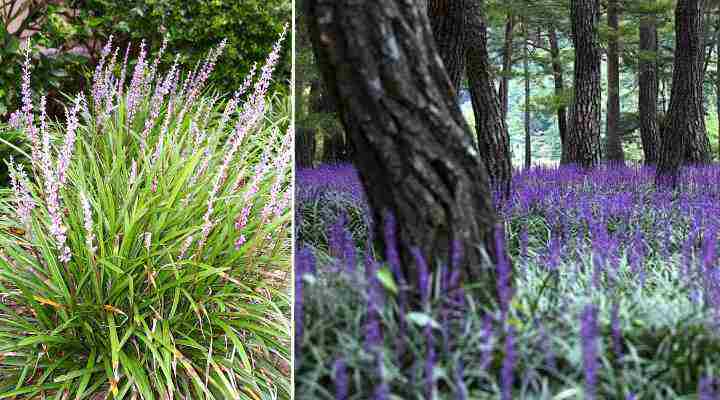
Monkey grass is a great foundation or border plant and is also decorative ground-cover for sun or shade
Monkey grass grows in shaded areas where other grass-like ground cover plants won’t grow. This creeping plant tolerates drought and full sun and doesn’t require much maintenance. Monkey grass is a decorative grass substitute for growing as a border or edging plant, on slopes to prevent erosion, or under shrubs.
Monkey grass plants are used as foundation plantings at the front of the house, flowering evergreen ground cover for full sun, planting between paving, or adding greenery to gravel gardens.
How to Care for Monkey Grass
To care for monkey grass, plant in well-draining soil and only water when the ground is parched. Trim the grassy foliage in winter or early spring to encourage healthy growth. During the growing season, hand pull any weeds around the creeping monkey grass clumps. It’s not necessary to fertilize monkey grass.
Types of Monkey Grass
There are two types of lilyturf or monkey grass plants (Liriope). Your choice of monkey grass for your front or backyard depends on the kind of plant you need—clumping or creeping. Liriope spicata is the creeping variety, and Liriope muscari is the clumping variety. Also, the flowers on clumping monkey grass are more pronounced than the creeping type.
Here are the two main types of monkey grass.
Creeping Monkey Grass (Liriope spicata)
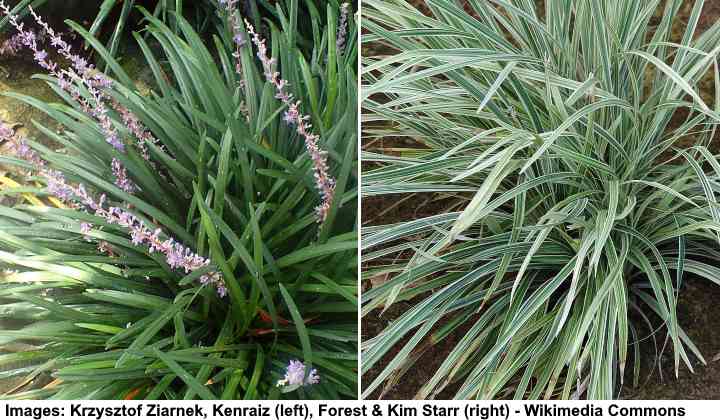
Creeping monkey grass (Liriope spicata) on the left and variegated monkey grass type on the right (Liriope spicata ‘Variegata’)
Creeping monkey grass (creeping lilyturf or Liriope spicata) is a popular ground cover plant that spreads rapidly. Creeping monkey grass is an evergreen perennial with arching, glossy green leaves that are 9” to 15” (23 – 28 cm) long and 0.25” (0.65 cm) wide. The variegated monkey grass cultivar Liriope spicata ‘Variegata’ has decorative leaves which are striped with green and creamy-white.
Creeping monkey grass produces small white to pale lavender flowers growing on short flower spikes.
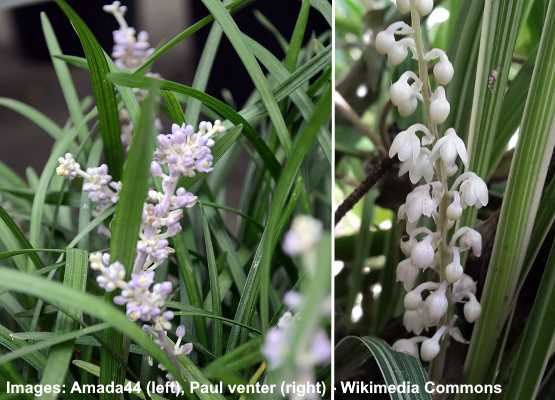
Liriope spicata flowers are white to pale purple
Clumping Monkey Grass (Liriope muscari)
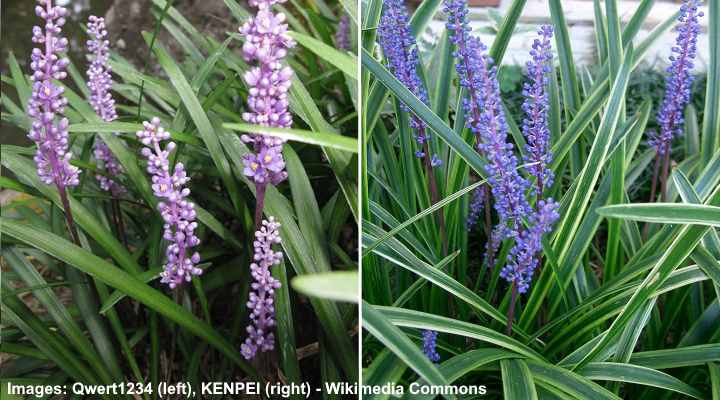
Clumping monkey grass (Liriope muscari) on the left and variegated type on the right (Liriope muscari ‘Variegata’)
Also called big blue lilyturf, clumping monkey grass is popular for growing as a border plant or ground cover. Clumping monkey plants have grass-like green blades up to 18” (45 cm) long. Because of the arching blade growth, the clumping plants grow between 10” and 15” (25 – 38 cm) high. The grassy blades grow up to 1” (2.5 cm) wide.
The variegated cultivar Liriope muscari ‘Variegata’ has attractive green leaves striped with creamy white.
Where to Plant Monkey Grass
You can plant monkey grass in almost any area of your garden. Because monkey grass thrives in the shade, the most popular place to plant it is shaded areas where other ornamental grasses and turfgrass can’t grow. You can plant monkey grass under shrubs and trees or along fences that are in constant shade.
Creeping monkey grass (lilyturf) grows best as evergreen ground cover due to its fast-spreading nature. Its dense and robust root system makes it perfect for preventing soil erosion on slopes. This Liriope species spreads over a wide area fairly quickly.
Clumping monkey grass plants (Liriope muscari) are ideal for paths, driveways, or flower bed borders. You can also plant this species as perennial ground cover in shaded or sunny areas.
Here are a few ideas on where to plant and grow monkey grass.
Grow Monkey Grass as a Border Plant and Grass Edging
Plant monkey grass (Liriope muscari) around beds and paths to create fluffy, evergreen edging. Space each tuft of monkey grass plant around 10” (25 cm) apart to allow the clumps of grass room to grow and spread. You can also plant clumps of monkey grass along sidewalks, driveways, or garden paths to create a flowering bushy border.
Plant Monkey Grass as a Ground Cover
Both types of monkey grass are ideal flowering ground cover plants. The plants are suitable for covering bare ground that is in continual shade. However, the clumping or creeping grasses grow just as well in sunny conditions. When in bloom, the plants produce flowers in hues of pink, purple, or white—perfect for your summer landscape.
Growing Monkey Grass in Containers
Monkey grasses are straightforward to grow in containers. Potted monkey grass plants add perennial greenery to balconies, patios, decks, or front door plantings. Plant monkey grass in well-draining potting soil and only water when the soil partially dries. If necessary, trim the spiky-looking foliage in late winter or early spring.
How to Plant Monkey Grass
Plant monkey grass in soil that drains well and contains a fair amount of organic matter. Dig small holes between 6” and 10” (15 – 25 cm) apart to plant the monkey grass tufts. Water regularly to keep the soil moist while the roots get established. Once established, only water monkey grass during prolonged drought.
Here are some more useful tips for planting monkey grass:
- Monkey grass grows well in USDA zones 5 through 10
- Plant monkey grass in sandy, loamy, or well-draining clay soil
- Lilyturf plants prefer slightly acidic soil
- The best growing advice is to prevent the rhizome roots from standing in soggy soil
- Monkey grass leaf color grows darker in shaded areas than in full sun
How to Propagate Monkey Grass
Root division is the easiest way to propagate monkey grass. Dig up tufts of the grassy blades and remove as much soil as possible. Try to divide the monkey grass roots by hand or use a sharp clean knife to split into individual plants. After dividing the roots, plant the monkey grass in your garden about 6” (15 cm) apart.
After replanting monkey grass plants, it’s vital to keep the soil moist for a few weeks until the roots establish themselves. Once you see new growth, you can reduce the watering frequency and care for the clumping grassy tufts as your other monkey grass plants.
You can also grow monkey grass from seeds. You can harvest seeds from the flowers or when the plant’s berries turn dark purple or black. However, monkey grass plants take a long time to grow from seed. Also, it’s tricky to harvest and prepare the lilyturf seeds so that they germinate successfully.
Trimming Monkey Grass
Trim monkey grass in late winter or early spring. Cutting back monkey grass helps to remove old foliage and encourage new, healthy-looking growth. Use your lawnmower on its highest setting to cut back the blades. If using a trimmer or garden shears, trim back foliage to around 3” or 4” (7.5- 10 cm) high.
It’s usually a good idea to trim monkey grass to keep it in its best condition. Older grass blades naturally turn brown and spoil its lush green appearance.
Monkey grass is a hardy plant that can withstand heavy pruning. However, to keep the plant looking its best, you must avoid damaging the crown when mowing it.
How to Water Monkey Grass
Monkey grass doesn’t require much watering when it’s established. The plant survives on little water, even in warm summer climates. You may need to water the plant every week if there is no rainfall. However, always check that the top layer of the ground is dry before watering.
You will need to water your plant regularly after planting new tufts of monkey grass. Moist soil helps the roots spread quickly to become established. When you see new growth on grass plants, you can water the clumps at the same frequency as other monkey grass plants.
Problems Affecting Monkey Grass Growth
Brown blade tips are the most common problem affecting monkey grass plants. In most cases, leaves turn brown as they become old and start to die off. However, many brown leaf tips on your grassy plants could indicate a fungal disease problem. Over-watering is the most common cause of browning monkey grass leaves.
Mowing monkey grass in early spring will remove dead, brown blades. However, if the plant is suffering from root rot, you will need to take more action.
If monkey grass leaves turn yellow and have brown tips, hold off watering until the soil dries. You may need to amend the ground to improve drainage if water tends to pool there. Species of monkey plants are susceptible to root disease if the soil is waterlogged.
However, if the ground is arid, you may need to give the plant a thorough watering. If so, always water in the morning to allow excess moisture to evaporate during the day. Then wait a week or two until the soil dries again before irrigating the soil. This watering technique will help the plant to recover and allow the roots to dry out.
If you notice that the monkey grass plant doesn’t recover, you’ll need to dig up the plant and dispose of it in the trash.
How to Control or Get Rid of Monkey Grass
The best way to get rid of monkey grass permanently is to dig it up. You should also remove as many of the surrounding roots as possible to prevent regrowth and keep it away for good. Although monkey grass is a popular ornamental grass for garden landscapes, it can become invasive.
After removing clumps, it’s a good idea to cover the area with landscape fabric. Preventing sunlight from getting to the ground helps to prevent new, unwanted growth. Diligence is also necessary as straggling roots tend to sprout and start growing.
Is Monkey Grass Poisonous?
Lilyturf or monkey grass is not toxic for cats, dogs, or other animals. The ASPCA lists plants in the family Asparagaceae such as Liriope muscari on their non-toxic garden plants’ list.
Some pet owners claim that their animals suffer stomach upset after ingesting monkey grass. However, there are no reported instances of the seeds or grass being toxic to humans or pets. Most animals that experience gastrointestinal upset after eating monkey grass or mondo grass also get upset stomachs after eating regular grass.
Related articles:
